MOMENTUM AiR
Shaarbek Amankul
12 January – 12 February 2020
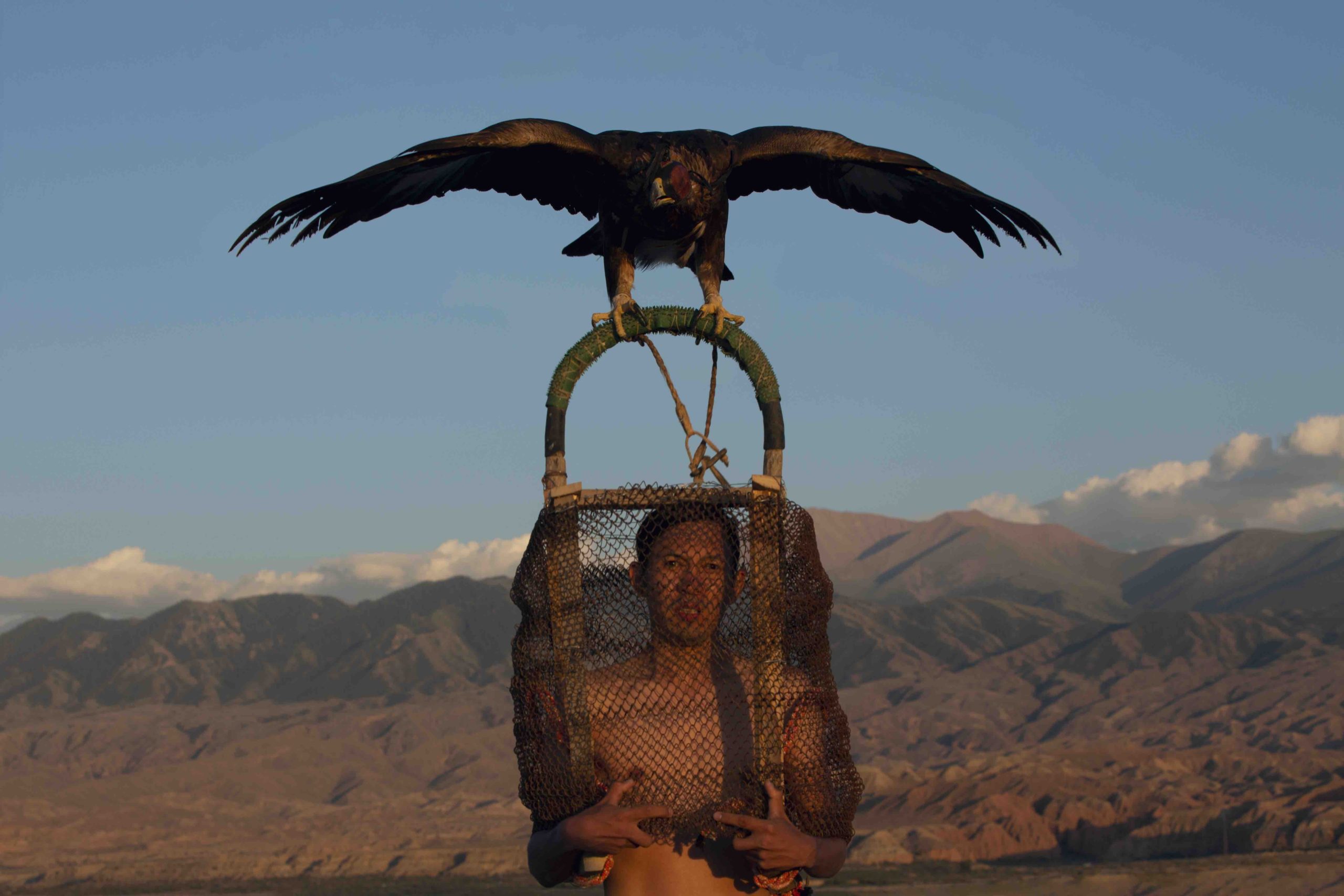
SHAARBEK AMANKUL
ARTIST TALK &
VIDEO SCREENING
9 February 2020 @ 4pm
@ MOMENTUM
Kunstquartier Bethanien
Mariannenplatz 2, 10997, Berlin
MORE INFO BELOW
PROJECT PRESENTATION
22 January 2020 @ 7pm
The Land where Horses Run Free
Artist Talk by Shaarbek Amankul
@ TOP – Transdisciplinary Project Space
Schillerpromenade 4, 12049 Berlin
Shaarbek Amankul (b. 1959. Lives and works in Bishkek, Kyrgyzstan) is a curator and interdisciplinary artist working with a variety of media: ceramic, sculpture, installation, performance, video and photography, in addition to conceptual research projects. Amankul holds art and history degrees from Frunze Art College, Bishkek, Kyrgyzstan (1980) and Kyrgyz National University (1989), respectively. Amankul founded the international artist group Art Connection (2001-2006), the first the art initiative in Kyrgyzstan focused on environmental issues. Amankul’s conceptual and curatorial work also includes the extensive art platform B’Art Contemporary, which he founded in 2007 to instigate a critical arts dialogue between the communities of Central Asia and the global art world.
B’Art Contemporary, amongst the very first contemporary art initiatives in Kyrgyzstan, is an artistic research platform which considers art as an essential facilitator of critical dialogue on environmental, social, economic and cultural issues faced by the societies of Central Asia. To continue his mobile art practice and artistic research, in 2011 Shaarbek Amankul founded the Nomadic Art Camp, a series of nomadic art projects in Kyrgyzstan, using the practice of the traditional way of life of nomads as a source of inspiration for contemporary art practices. The project, continuing to this day, focuses on the relationship between art and the political, economic and social processes at the intersection of issues of globalization, migration and bio-cultural diversity.
Scroll Down for Extended Artist Bio
Watch the video of the Shaarbek Amankul’s artist talk at MOMENTUM:
SCREENING PROGRAM
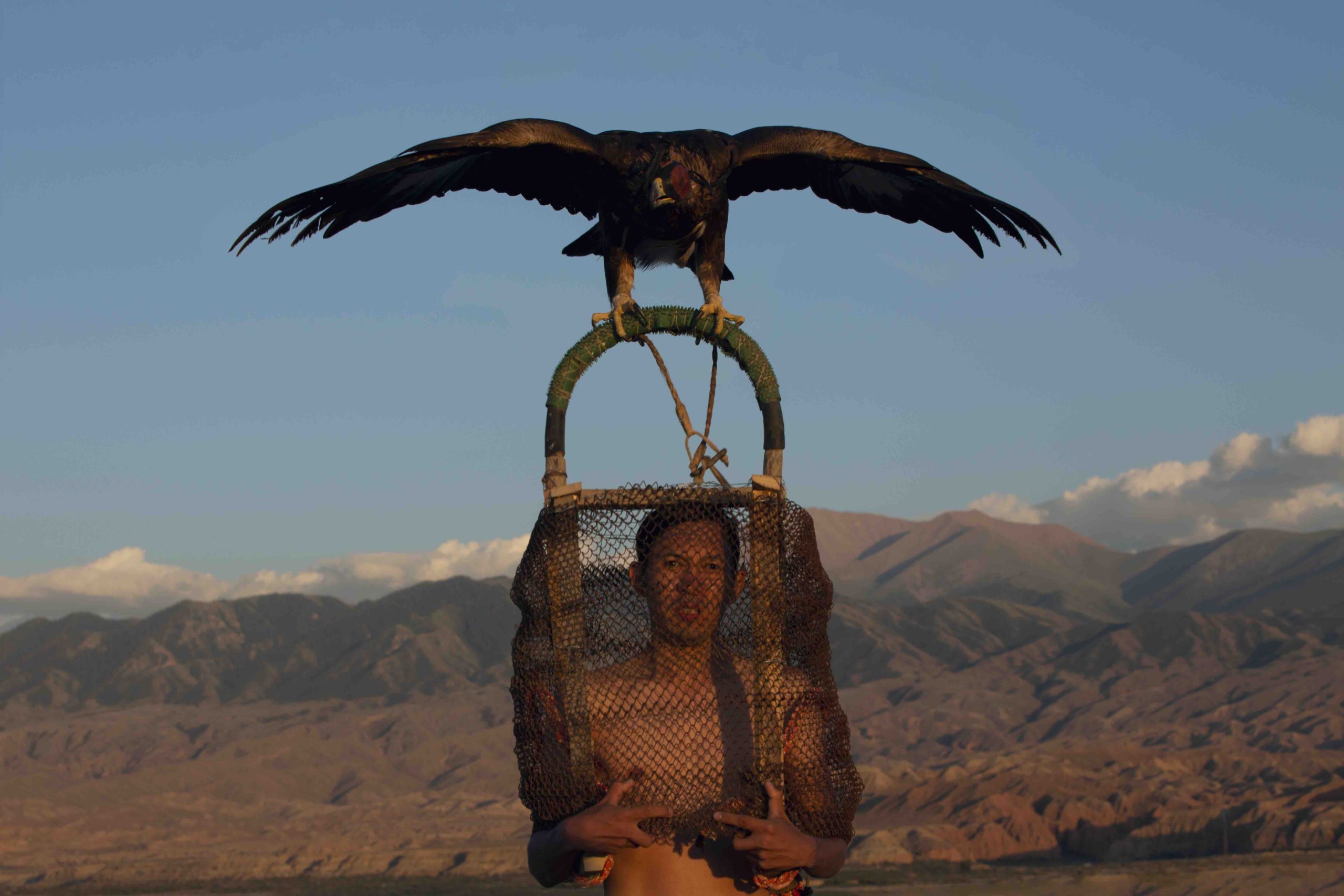
Flight of the Blind Eagle
2019, video performance, 1’ (designed to loop)
Kyrgyzstan has gone through a difficult path of searching for happiness and selfhood. Having passed through many historical ages, the Kyrgyz people still have not found an autonomous and holistic vision of themselves – as individuals, a people, a society, a state – and a path toward their future development. Today, such rethinking is a paramount task for society. Eternity has a special grace – it opens its veils even when we are blind and blind others. It gives freedom of choice even when we deprived ourselves and others of freedom. [Shaarbek Amankul]
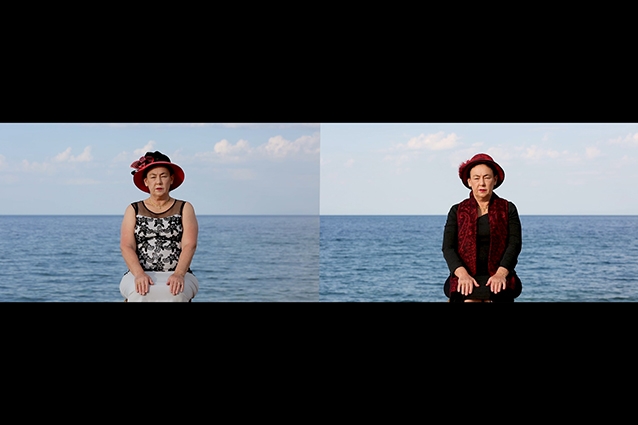
Untitled
2019, video performance, 1’ (designed to loop)
As one hypothesis, suggests that in order to move forward, visions of historical identification must be critically examined as the phantoms of consciousness they are. These figures, literally burdened by different headwear, are dressed in the color worn by woman exploring new universes and ghosts from another time or mind, their movements bound to one another in a counter-argument to the nomadic symbol of impossible autonomy. Both a figurative image and a literal image, whose very body is visually fragmented, becoming part of the landscape itself. [Shaarbek Amankul]
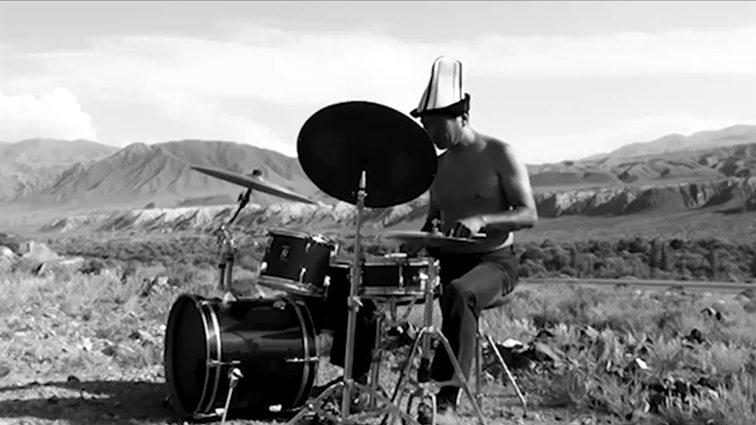
Drinking the Wind
2020, 5’
For centuries, the nomadic people coexisted with animals; they were indispensable helpers living in symbiosis. Intercutting film footage from 1965 taken from the Kyrgyz State Film Archive, with a video performance shot by Amankul, this work investigates mythologies of the figure of the nomad, both in Kyrgyz culture and global ideology. How can Central Asia continue to draw from the traditional idea of the nomad so crucial to cultural history, while moving past clichés and into transformative models about contemporary identity? What to do locally for survival in the globalizing world? Does breaking with old archetypes necessitate the loss of history? [Shaarbek Amankul]
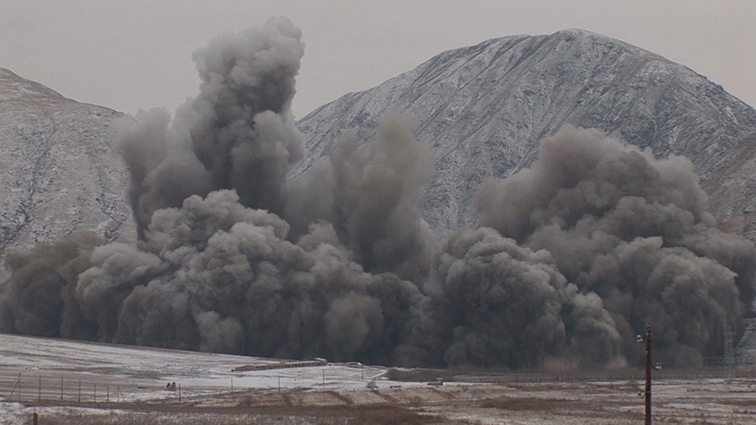
End of Nature
2010/2020, 3 channel video, 3’
Designed as a 3-channel video installation, this project reminds us of our dependence on nature – destroying it we destroy our habitat and thus destroy ourselves. Our sense of omnipotence is a myth; as humans, our well-being depends on the well-being of nature. The work is a manifesto calling for the preservation of biological and cultural diversity as a part of our identity. In a country riddled with Uranium mines, and a legacy of selling its natural resources to support foreign interests, the destruction on the screen can be seen as but a chilling preface to the devastation ahead. With original footage shot in 2010, however, this work was made after the Kyrgyz government ban on Uranium mining in 2019.
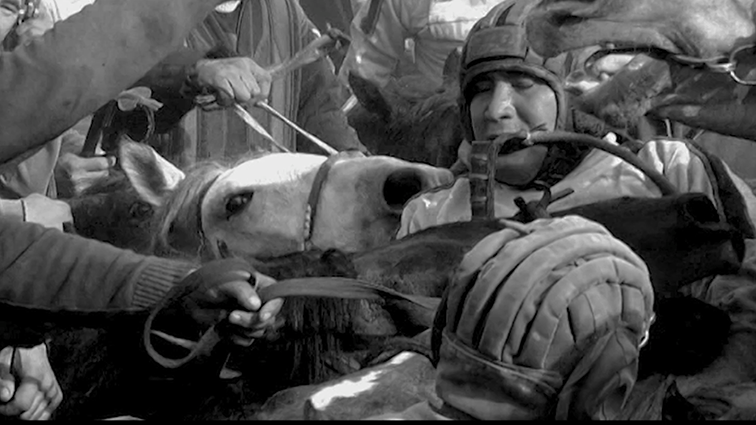
Kok Boru / Grey Wolf (Capricornus AUTHORITIES)
2011, 1’09” (original 5’)
Kok Boru, the national game of Kyrgyzstan and Kazakhstan, has its origins in traditional nomadic culture, when hunters and shepherds would go after the wolves decimating their livestock. According to legend, having caught up with the pack, they would pick up running wolves from the ground, throwing them between each other almost playfully. The game today requires teams on horseback to throw a dead sheep or goat into their opponent’s goal on the playing field. The cultural origins of the game are combative. While playing Kok Boru, men and horses were taught to be fearless, courageous, and daring; qualities needed by warriors. ‘Kok Boru’, translated as ‘Grey Wolf’, is viewed by many today as their primary link to the cultural legacy of their forebears as nomads.
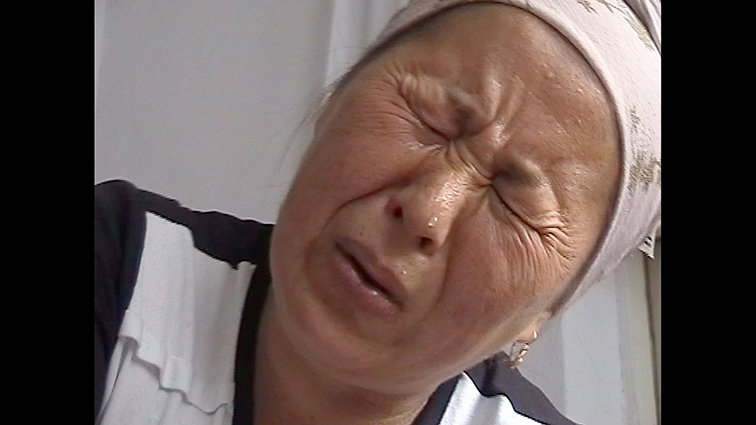
Duba
2006, 3’05″ (original 6’56″)
Shamans are healers who use traditional practices to cure people of ailments, triggering natural forces on a subconscious level to help overcome illness. On screen, there’s only a close-up of a face – the fascinating physiology of a trance – a shaman performing a ritual. The title of the work ‘Duba’ means ‘cleaning the soul’. In Kyrgyz culture scientific explanations can be ineffective since many people do not trust logic. The realm of informal medicine and inexplicable phenomena is often more convincing than science. This era of complex conditions of social upheaval and rapid changes within the fields of technology and communication lead to feelings of inadequacy and a loss of identity. People therefore turn to shamans to obtain treatment for their illnesses. The irrational is a form of restoration lost identity. [Shaarbek Amankul]
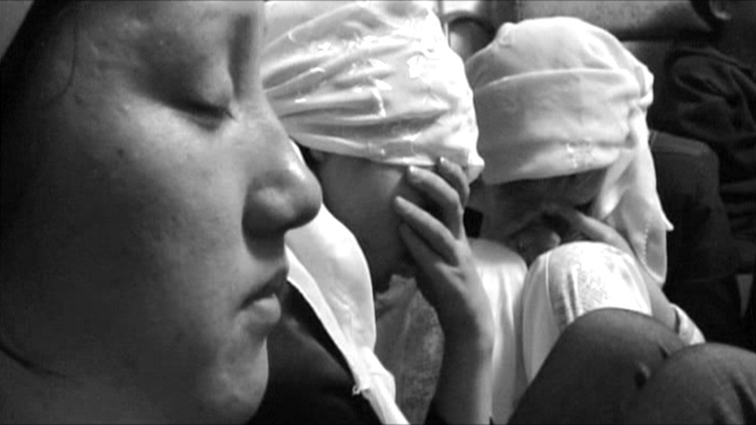
Sham
2007, 4’20″
Like “Duba”, this work documents a cleansing ritual. The unconventional appears most likely to gain a foothold in the Post-Soviet Era of no fixed paradigms. In this place, they believe in and hope for miracles. And only the shaman can enter a trance. In this state of mind, they read prayers, they yawn and cry from excitement; they scream and belch from sicknesses of both body and mind. Strange how they meditate, scratching and beating one another. And afterwards, according to credible sources, they often don’t remember what happened to them. They will conclude that everything happened by the will of higher powers. Once they’re purified and blessed like this, they can live on more peacefully.
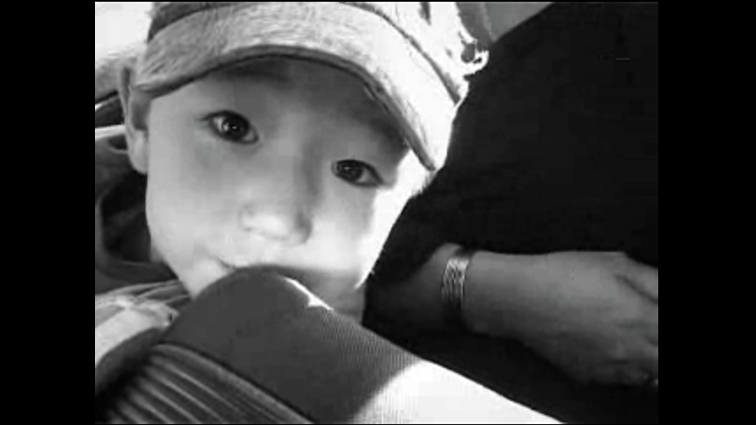
Circumcision
2011, 3’43″ (original 4’10″)
Documenting the traditional circumcision ceremony of the artist’s nephew, this work is another chapter in the portrait of his nation, which Shaarbek Amankul unblinkingly captures on film, from intimate familial moments to explicit scenes viscerally impossible to watch. During the modernization of Kyrgyzstan in Soviet times, the tradition of circumcision was banned, but was nevertheless performed in secret in often unsanitary conditions without appropriate medical instruments. Today this right of passage is performed in official institutions by countless families free to practice their cultural and religious traditions.
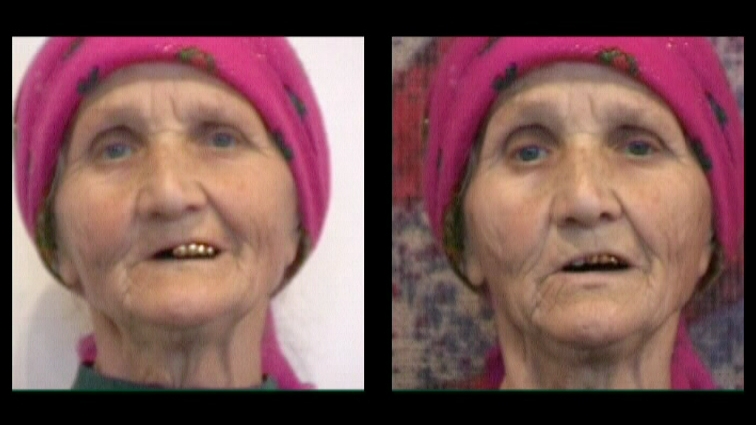
Song
2007, 4’35″
This work is yet another chapter in Shaarbek Amankul’s portrait of life in his culture; everyday moments, both fleeting and eternal, abstract and real, poetic and commonplace. It is both a portrait of the many normally invisible, a cleaning lady polishing the floors, and a strikingly individual close-up of an idiosyncratic character.
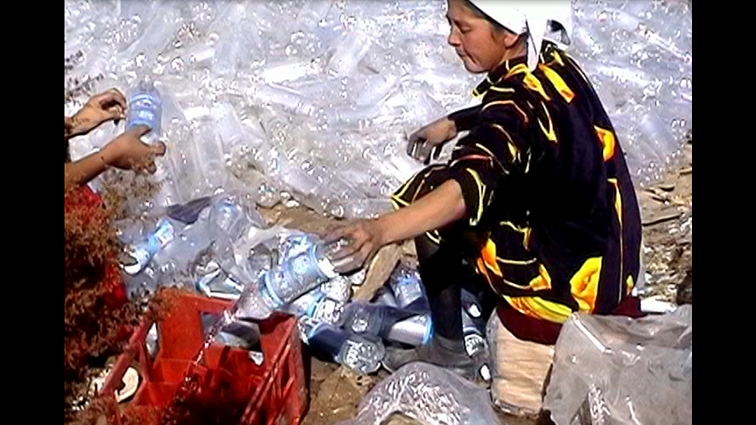
New Society
2006, 1’
The video New Society shows poor villagers on the outskirts of the Kyrgyz capital, Bishkek, emptying aid packages of bottled water onto the arid ground so they can recycle the plastic for cash. The devastating irony by which the normally environmentally sound practice of recycling results in the wastage of water is a reflection upon the economic privation and shortsightedness wherein a population comes to prefer the quick cash from recycling to the water itself. This twisted take on the water economy is devoted to the search for social identity on the part of thousands of residents of the suburbs of Bishkek. This work looks at the population who left their villages after the collapse of the Soviet Union, only to remain marginalized to this day by the city infrastructure through unemployment and poverty.

Artist
2011, 1’ (original 9’40″)
This is a documentary portrait of a disabled street artist in Bishkek. Unable to use his arms, Tolon paints with his legs, selling his work in underground passages around the city. Not a prurient glimpse of the carnivalesque, rather this is an homage to one individual’s strength of will. Surviving through the dexterity of his legs – eating, drinking, drawing pictures, calculating money – he paints lusciously colorful pictures of popular stars and singers. A figure both abject and heroic, there is in his work something really original.
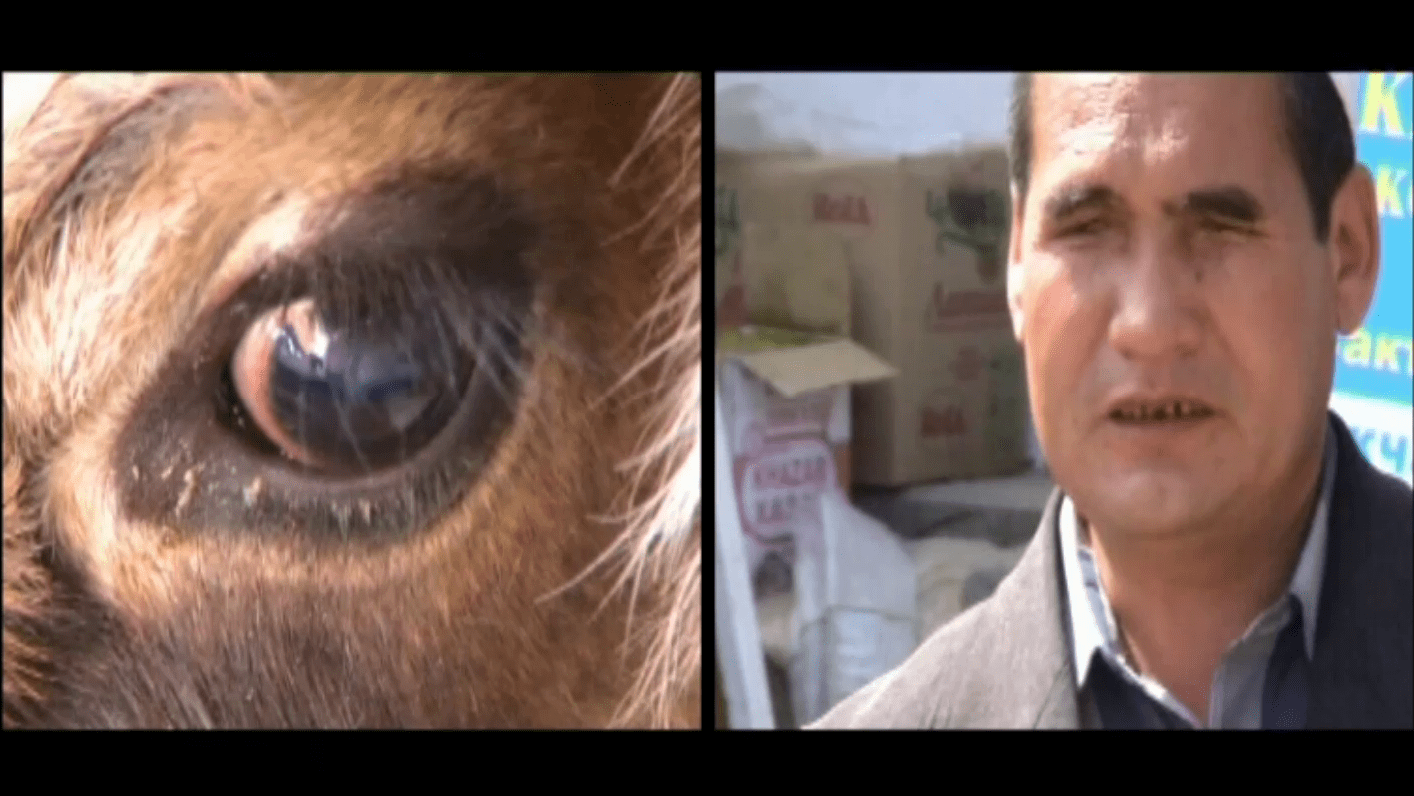
We Need To Live
2007, 4’33″
Editing documentary footage within a poetic structure, Amankul’s videos have tracked the fundamental social, political and cultural changes that have taken place in Kyrgyzstan since it gained independence from the USSR in 1991. During this time there has been considerable civil unrest and a move from a secular to an Islamic state culture. The two-channel film examines, in brutal counterpoint, the tragic discrepancies between propaganda and reality, as well as the ludicrous faces of state power, inhumanity, wastage of resources and civil unrest.
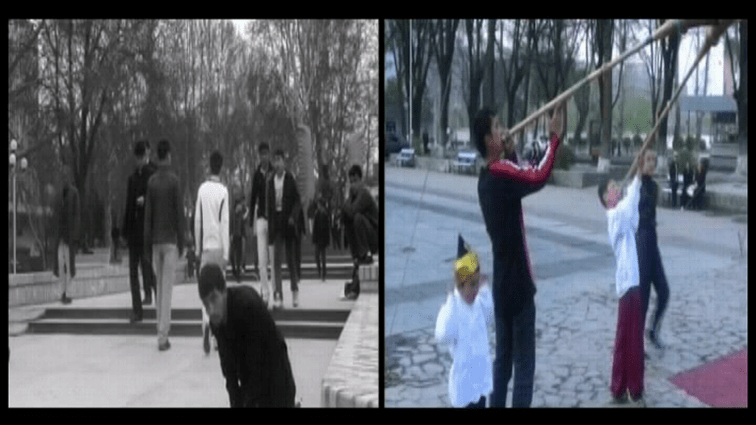
VATAN / Homeland
2007, 4’34″
Another work in the series of video-portraits of Kyrgyzstan, capturing the many contradictions of a culture ravaged by political and religious colonization, regime change, and modernization, still in search of its post-Soviet identity. Expanding upon the tragic, and at times absurd counterpoints of the human condition in Kyrgyzstan, Amankul shows us an Eastern Bazar, passers-by and cripples, traders and beggars; dancing girls and a border post; demonstrations and moments of revolutionary turmoil; the beating of “enemies of the people” at rallies; and acts of self-immolation; celebrations and riots, the dark and light sides of life; and a lullaby to appease the passions, a mother’s request for clemency.
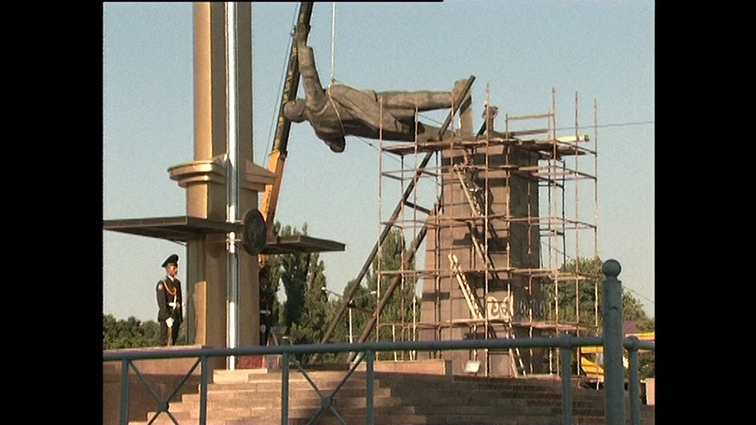
Lenin Stands – Lenin Fell Down
2003, 1’30″
With the advent of Communism in Kyrgyzstan, pre-Soviet ways of life were transformed as nomads became fighters for an international revolution, farmers became citizens, and Muslims became atheists. In the central square of Kyrgyzstan’s capital, Bishkek, Lenin’s sculpture proudly stood from 1982 to 2003. In an almost comic case of cultural confusion, even after gaining their independence, masses of former communists came to pray beneath this statue; the worship of Communist ideology giving way to the mass prayers of Ramadan. Lenin towered above this square until 2003, when he was brought down from the facade of the Historical Museum (the Museum of Revolution until 1992), and moved to its backyard. This procedure, though oddly ceremonial, was not advertised by local authorities. This work captures a rare historic moment – Lenin in flight, suspended between a past of failed ideologies, and an uncertain future. The ceremony of the changing of the guard – so appropriate to this notable event – is ironically incidental to it, taking place every day at this location, and clearly oblivious to Lenin’s historic flight.
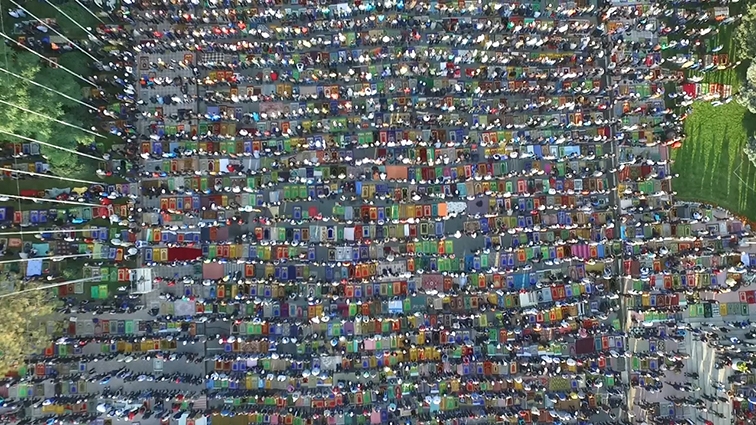
Puzzle of Identity
2020, 1’30″ (designed to loop)
The collapse of the USSR with its idea of communism has led to a new renaissance of Islam in post-soviet Kyrgyzstan. Every year during the holy month of Ramadan, thousands of Muslims – many of whom in the past were devoted custodians of communist ideology – gather for a collective holiday prayer on the central square near the Lenin monument and the Parliament of the Kyrgyz Republic. Historically, the square hosted grand Soviet parades glorifying socialism. Today it is a space for strictly framed religious practices. The influence of Islam is growing at an enormous speed. On one hand western civilization replaces socialist values, on the other hand traditional values and spirituality based on religion have revived. [Shaarbek Amankul]

Transformation
2005, project documentation video, 12’14″
Transformation is a project curated by Shaarbek Amankul as part of his Nomadic Art initiatives, inviting international artists to examine the social and political issues of Central Asia: the movement from a totalitarian crisis of public and political life to open civil society. The project took place 2005 amidst the derelict buildings of a former secret soviet military base which produced uranium from the waters of Lake Issyk-Kul in Kyrgyzstan. Here the ruins of the architecture represent not merely potential ecological catastrophe, in their echoing of Chernobyl, but in the casting off of a place through the implacability of capitalism. This contradiction, the history and reason for the existence of the buildings opposed to the natural surroundings, embodies inspiration for investigations of topics such as spirituality, globalization, international terrorism, and dictatorship. [Shaarbek Amankul]
Selected Group Exhibitions
Beyond numerous exhibitions held in various countries of the Soviet Union, he has exhibited in US, Europe, Asia like World Contemporary Art 98, Los Angeles, 1998; Art in Action, Oxford, 1999; No Mads Land, Haus der Kulturen der Welt, Berlin, 2002; Transforma, Centre d’Art Contemporain, Geneva, 2002; 43rd Premio Suzzara, Galleria Civica d’Arte Contemporanea di Suzzara, Italy, 2003); Central Asian Pavilion at the 51st Venice Biennale/videoarchive, 2005; Intersection, Modern Art Gallery, Ulan Bator, 2007; 2nd Singapore Biennale, 2008; Zindan/Vatan/Duba, Kunsthalle/Spiegel, Lothringer13, München, 2009; Biennale Cuvée, OK Center for Contemporary Art, Linz, 2009; The View from Elsewhere, Sherman Contemporary Art Foundation, Sydney, 2009; Queensland Art Gallery / Gallery of Modern Art Brisbane, 2009; Changing Climate: New Media and Video Art from Central Asia, Kunsthalle Exnergasse, Vienna, 2009; 22nd Les Instants Vidéo Festival, Marseille, 2009; Video and Performance Art Festival, Ramallah, 2011; Between Heaven and Earth: Art from the Centre of Asia, Gallery Calvert 22, London, 2011; Introspection, Ya Gallery, Kyiv, 2013; Crossroad: Contemporary Art from Central Asia & Caucasus, Sotheby’s, London, 2013; Video from Elsewhere, Edinburgh, 2013, Edinburgh; Call and Response with George Steinmann, Kunstmuseum Thun, Switzerland, 2014; Balagan! Contemporary Art from the Former Soviet Union and Others Mythical Places, Kühlhaus-Berlin, 2015; Flight of a Blind Eagle, Kyrgyz National Museum of Fine Arts, Bishkek, 2017; Posttotal, Kyrgyz National Museum of Fine Arts, Bishkek; Collection, Kyrgyz National Museum of Fine Arts, Bishkek, 2019; Water(Proof), MOMENTUM, Kunstquatier Bethanien, Berlin, 2019; Planet Art Festival of Nature, Kühlhaus-Berlin, 2019; Water(Proof), Federation Square Melbourne, 2019; Shamanism and Contemporary Artists, Gallery 46, London, 2020; Waldwolfwildnis, Museum Villa Rot, Baden-Württemberg, Germany, 2020; Project Stoa 169, Polling, Germany (Sculpture Park opening to the public 2022).
International Artist Residencies
House of Art Foundation USSR (1989-91, Latvia); Berkshire Artist’s Settlement (1998, NY); International Artist in Residence Krems (2003, Austria); Print Graphic Academy (2005, Austria); Vermont Studio Center (2005, USA), CECArtslink Global Art Lab (New York / San Francisco); International Artist Residence Villa Waldberta (2011, Germany); MOMENTUM (2020, Berlin, Germany).
Conferences & Symposiums
Urban Ceramic (1996, Tashkent, Uzbekistan); Ceramic in Artchtecture UNESCO (1997, Samarkand, Uzbekistan); 10th Istanbul Biennale Conference “International Discourse vs. Local Vibrancy: Challenges and Opportunities in the Practice of Art in Central Asia” (2007, Istanbul); CIMAM Annual Conference “Contemporary Institutions as Producers in Late Capitalism” (2007, Vienna); Intersection: Contemporary Art (2007, Ulan Bator, Mongolia); Art Hub / New Silk Road (2009, Bangkok, Tailand); International Sculpture and Land Art (2009, Bad Tolz, Germany); CIMAM Annual Conference “Common Ground for Museums in a Global Society” (2010, Shanghai); International Terracotta Art (2010, Eskishekir, Turkey); General Assembly of International Academy of Ceramic (2014, Dublin); Culture Summit (2017, Abu Dhabi); International Colloquium in Contemporary Philosophy and Culture “Home & Journey around the Globe” (2019, Bishkek), Asia Art Space Network Forum (2019, Gwangju).
WITH THANKS FOR GENEROUS SUPPORT
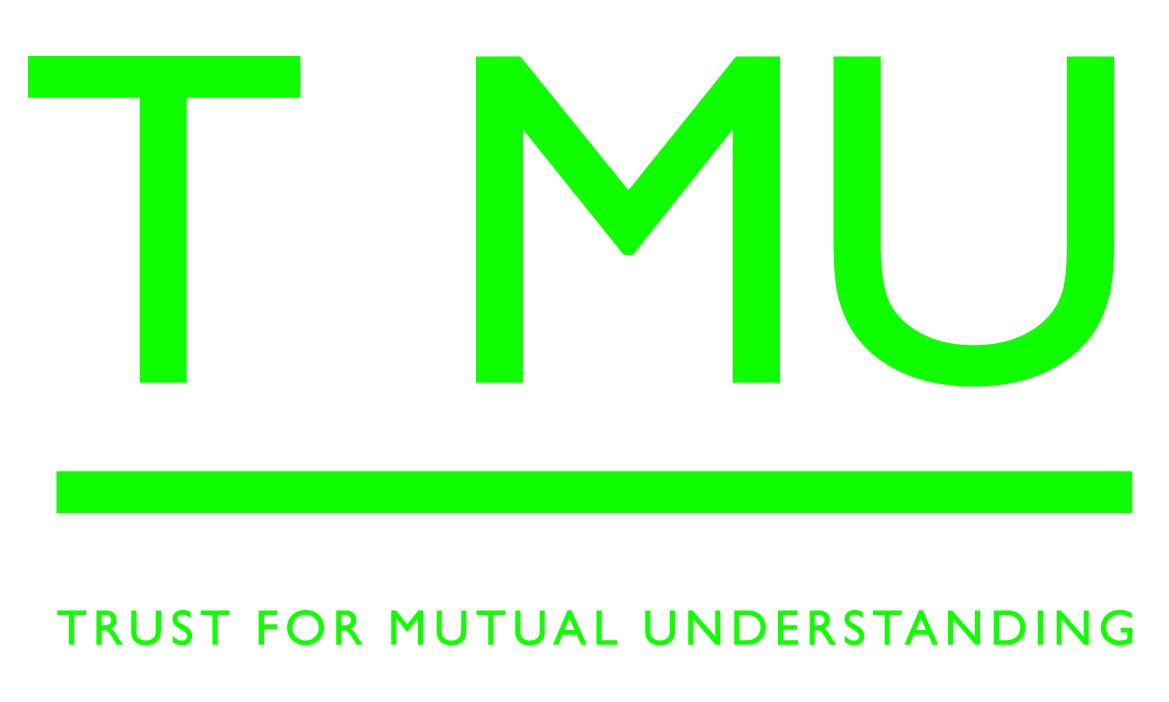
ABOUT TMU
The Trust for Mutual Understanding was established in 1984 by an anonymous American philanthropist as a private, grantmaking organization dedicated to promoting improved communication, closer cooperation, and greater respect between the people of the United States, the Soviet Union, and other countries in Eastern and Central Europe. TMU’s program reflects her conviction that grantmaking can make a contribution to that process by supporting international face-to-face contact and professional interaction. TMU’s mission has been shaped by the belief that creative international collaboration encourages global harmony. TMU continues to support East-West exchanges in the arts and environment, reflecting the founder’s appreciation of the importance of culture and ecology in people’s lives. Before 1985, there was relatively little American funding for such activities, and what support there was — mainly governmental — was often restricted by political considerations. It remains TMU’s goal to enable talented people to come together from different countries to freely share ideas and stimulate creativity in a nonpolitical context.


 Back to Index
Back to Index